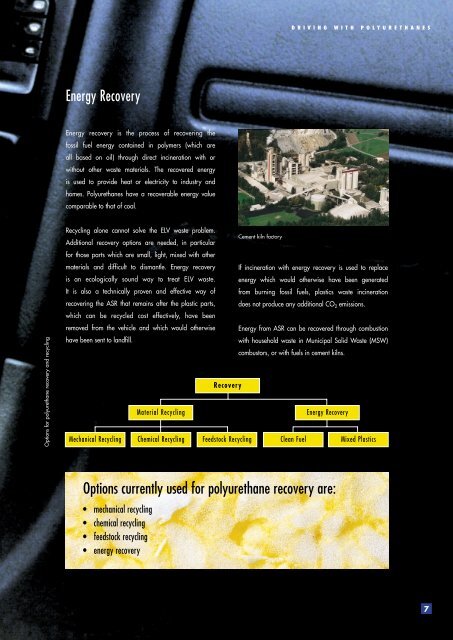DRIVING WITH POLYURETHANES
1fGMxsM
1fGMxsM
Create successful ePaper yourself
Turn your PDF publications into a flip-book with our unique Google optimized e-Paper software.
<strong>DRIVING</strong> <strong>WITH</strong> <strong>POLYURETHANES</strong>Energy RecoveryEnergy recovery is the process of recovering thefossil fuel energy contained in polymers (which areall based on oil) through direct incineration with orwithout other waste materials. The recovered energyis used to provide heat or electricity to industry andhomes. Polyurethanes have a recoverable energy valuecomparable to that of coal.Options for polyurethane recovery and recyclingRecycling alone cannot solve the ELV waste problem.Cement kiln factoryAdditional recovery options are needed, in particularfor those parts which are small, light, mixed with othermaterials and difficult to dismantle. Energy recovery If incineration with energy recovery is used to replaceis an ecologically sound way to treat ELV waste. energy which would otherwise have been generatedIt is also a technically proven and effective way of from burning fossil fuels, plastics waste incinerationrecovering the ASR that remains after the plastic parts, does not produce any additional CO 2 emissions.which can be recycled cost effectively, have beenremoved from the vehicle and which would otherwise Energy from ASR can be recovered through combustionhave been sent to landfill.with household waste in Municipal Solid Waste (MSW)combustors, or with fuels in cement kilns.RecoveryMaterial RecyclingEnergy RecoveryMechanical Recycling Chemical Recycling Feedstock RecyclingClean FuelMixed PlasticsOptions currently used for polyurethane recovery are:• mechanical recycling• chemical recycling• feedstock recycling• energy recovery7



